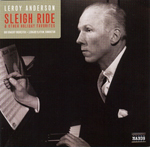J.S. Bach: Six Concertos from the Margrave of Brandenburg • Trevor Pinnock and the European Brandenburg Ensemble • Avie AV 2119
- Performance:

- Sound:

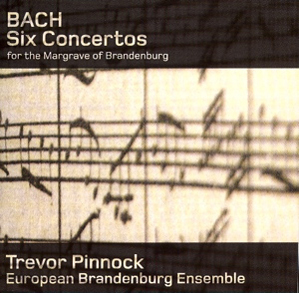
It’s easy to dismiss Bach’s six Brandenburg Concertos assonic wallpaper. Their presence on classical FM, internet radio, iTunes, andconcert programs around the world is virtually as ubiquitous as Vivaldi’s not-always-evergreen Four Seasons. Most recordings, however, are dismayingly routine, with modern instrument players sawing and blowing away as if executing these babies was just another gig on the calendar.
Hold on to your harpsichord, partner. If you think you know Bach’s six Brandenburg Concertos inside and out, take a listen to this award-winning two-CD set. Under the hands of harpsichordist/conductor Trevor Pinnock and his authentic instrument ensemble, countless unexpected sonorities emerge. “I don’t recall ever having heard that trumpet there,†you may exclaim.“ Why didn’t I ever hear that bass line before? Have I ever experienced the Minuet in Concerto No. 1 sound so stately, elegant, and delightfully danceable?†And then, after countless sonic revelations, you will likely end up marveling anew at Bach’s seemingly endless mastery of invention.
The European Brandenburg Ensemble recorded these concertos under emotional duress. On the night after their first rehearsal, principal viola player, Katherine McGillivray, died from an undiagnosed brain tumor. After dedicating their efforts to McGillivray’s memory, her colleagues devoted every iota of heart and spirit they could summon forth to this recording. Performing at standardized baroque pitch, they have created the revelatory Brandenburg Concerto set to cherish.
Best of Heart of Space: No. 1 First Flight • Hearts of Space 2-HOS-11500
- Performance:

- Sound:


Is there any New Ager, stoner, or space cadet who has not been touched by Music from the Hearts of Space? The syndicated radio show, founded by Stephen Hill and the late Anna Turner, debuted in the fall of 1973 on the mothership of alternative radio, Pacifica Radio’s KPFA-FM in Berkeley, CA (where else?). Ten years later, the show went national. By 1985, over 200 public radio stations were beaming HOS’s “space music” mix, punctuated by Hill’s airy musings, to millions of listeners nationwide.
Now, in celebration of HOS’s silver anniversary, Valley Entertainment has begun releasing classic shows from the HOS archives. Where better to start than with the very first music mix that launched the series nationwide? The names on No. 1 First Flight will ring nostalgic for those familiar with the well-known New Age composers of the past 30 years. Kitaro, Irene Papas & Vangelis, Thomas de Hartmann, Michael Sterns (three selections from his great Planetary Unfolding), the irreplaceable Deuter, Paul Lloyd Warner & Steve Kindler, and David Darling are all musical visionaries whose electronic and acoustic soundscapes have helped elevate consciousness (and maintain sanity) in a political era that extends from Reagan to the madman W and his anything-but-altered consciousness “family values” cohorts. You won’t need your oxygen mask for this journey, but be sure to fasten your seat belt before lift-off.
Bobo Stenson Trio: Cantando • ECM 2023
- Performance:Â

- Sound:Â

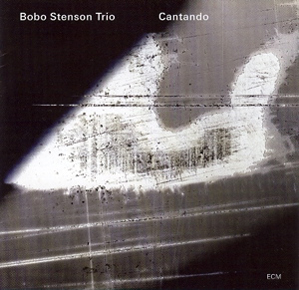
Songs in name only, these are actually soulful journeys -11 in total – into the minds of pianist Bobo Stenson and his accomplices in rarefied jazz, double-bassist Anders Jormin and his trio’s new, 29-year old drummer, Jon Faït. Many of the selections, such as Astor Piazzolla’s eight-minute “ChiquilÃn de BachÃn (arranged by Jormin) and the trio’s almost fourteen-minute “Pages,” are quite extended in length. Weird juxtapositions abound, as when bells jingle in the middle of “Pages” as though summoning the master to supper. Shortly after “A Fixed Goal” by jazz great Ornette Coleman comes, quite surprisingly, a jazz take on one of twelve-tone composer Alban Berg’s gorgeous early songs from 1907, “Liebesode.”
Trying to get a handle on this music using the rational, sequential mind won’t get you far. These men are singing, soaring, flying, coasting, searching, grooving. You may not speak the language, but the sound is so compelling, the recording so clear, that you may find yourself wanting to learn. Where you’re going is not exactly clear, but that’s not the point. You can feel the music on the purely physical level, and explore new levels of sensate experience, or you can turn out the lights and leave the physical far behind. Fait is a far more interventionist drummer than the great Paul Motion, who recorded with the trio a few years back, so it’s a new trip altogether. For more on this collaboration, check out: http://www.ecmrecords.com/Background/2023.php.
Paul Robeson: The Complete EMI Sessions 1928-1939 • EMI 509999 2 15586 2 (7-CD set)
- Performance:Â

- Sound:Â

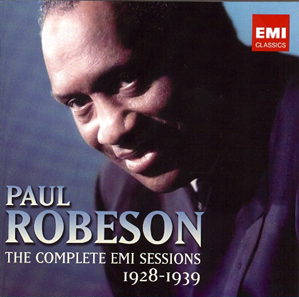
“It is my firm intention to continue to speak out against injustices to the Negro people, and I shall continue to do all within my power on behalf of independence of colonial people in Africa, †African-American athlete, bass, actor, and activist Paul Robeson attempted to tell Richard Nixon, Sen. Joe McCarthy and their House Un-American Activities Committee. They wouldn’t let him speak; nor would they allow the star of Jerome Kern’s Showboat and Shakespeare’s Othello to obtain a passport to again sing abroad. Thankfully, the son of William Drew Robeson, who was born into slavery in 1845, would not be silenced. After an international outcry, he was able to return the stage of Royal Albert Hall in London in 1958, as well as to Moscow and Berlin, building upon a reputation that began shortly before he made his first recording for the company ironically titled His Master’s Voice (HMV).
Nothing speaks as eloquently of Robeson’s achievements than this remarkable collection of spirituals, slave songs, Russian classics, and folk songs. The night before I learned that Barack Obama would become the next President of the United States, I listened to Robeson sing “Dere’s a man goin’ round takin’ names, †“No more driver’s lash for me, many thousand gone, †and “Ole Man River, †and reflected upon America’s legacy of inequality and racism. May the freedom for which Robeson fought, which ultimately includes the right of everyone to marry, finally prevail.
Lorraine Hunt Lieberson: Lorraine Hunt Lieberson at Emmanuel • Avie AV2130
- Performance:Â

- Sound:Â


Priceless live recordings continue to surface that preserve the mesmerizing artistry of Lorraine Hunt Lieberson at the point of creation. The soulful voice of the incomparable mezzo-soprano, who left her body from cancer on July 3, 2006 at the age of 52, continually vibrated with feeling. Hunt Lieberson sang with such naked intimacy that barriers between her and her audiences were constantly transcended, as all present united in a revelatory experience of emotional truth.
One of the newly issued CDs, recorded 1992-1999, affords a glimpse into the many years Lorraine sang at Emmanuel Church in Boston with the late conductor Craig Smith and The Orchestra of Emmanuel Music. The opening two arias from cantatas by the Johann Sebastian Bach display her impeccably musical, liquid line, in which every note and syllable speaks to realities spiritual and eternal. The remainder of the CD – excerpts from Hunt Lieberson’s English language performance of Dejanira in G. F. Handel’s Hercules – bring us even closer to her capacity for emotional honesty.
The greatest miracles, however, may be heard in the live recital from Wigmore Hall discussed below.
Lorraine Hunt Lieberson: Lorraine Hunt Lieberson at Wigmore Hall • Wigmore Hall Live WHLive 0024
- Performance:Â

- Sound:Â

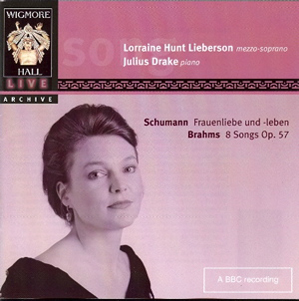
Recorded on October 4, 1999, with Julius Drake at the piano, Hunt Lieberson brings such sensuality and depth of feeling to the eight Op. 57 songs of Johannes Brahms that it hardly seems necessary to follow the translations in the booklet. One of these masterpieces, the oft-recorded “Es träumte mir” (I dreamed), conveys the deep yearning of a lover for whom intimacy with the beloved is only a dream. The longing, and pain are as accessible as Dorothea Lang’s iconic images of homeless migrant families trying to survive during the Depression, or pictures of Iraqis mourning the victims of another attack.
Equally powerful are two groups of songs by Robert Schumann. Having heard Lorraine sing the eight songs in Schumann’s iconic song cycle, Frauenliebe und leben (A woman’s life and love), in Berkeley, shortly after she recovered from her first bout with breast cancer, I confess that I as yet cannot bring myself to listen to this performance. I recall sitting transfixed in the hall filled with 2400 people, feeling as if her every word was describing my own feelings for someone I was in love with at the time. Especially poignant was Hunt Lieberson’s gaze on her husband, composer Peter Lieberson, who was in the audience. Her singing is so real, so pregnant with emotion and yearning, that I’m still not ready to revisit the experience. Instead, I revel in her encores by Debussy and Handel. As Lorraine sings “Angels, ever bright and fair, Take, o take me to your care, ” I feel gratitude for the rare gifts she left behind. Bless you on your journey, Lorraine Hunt Lieberson.


